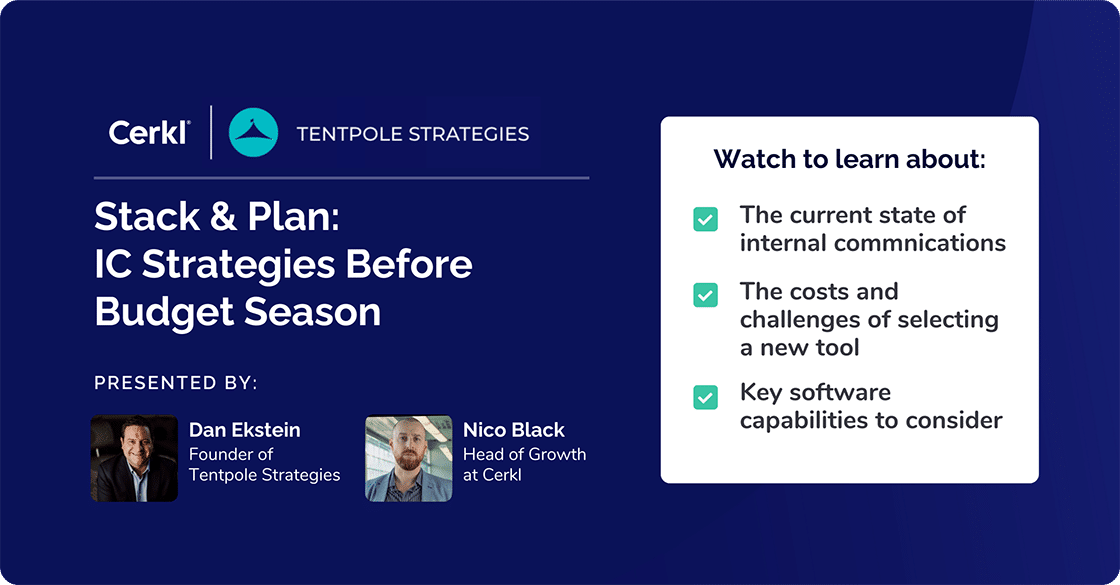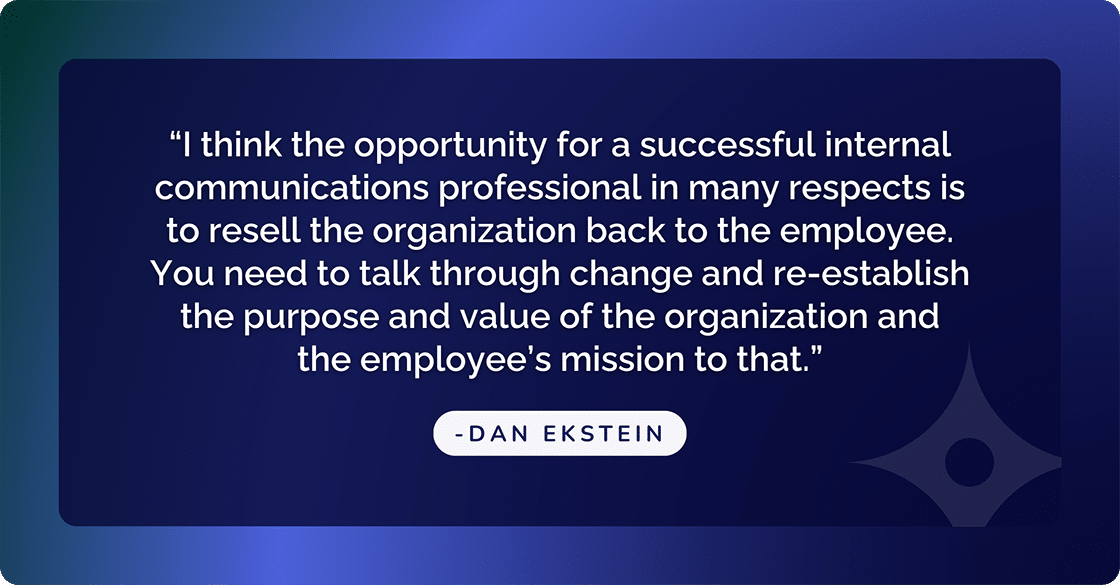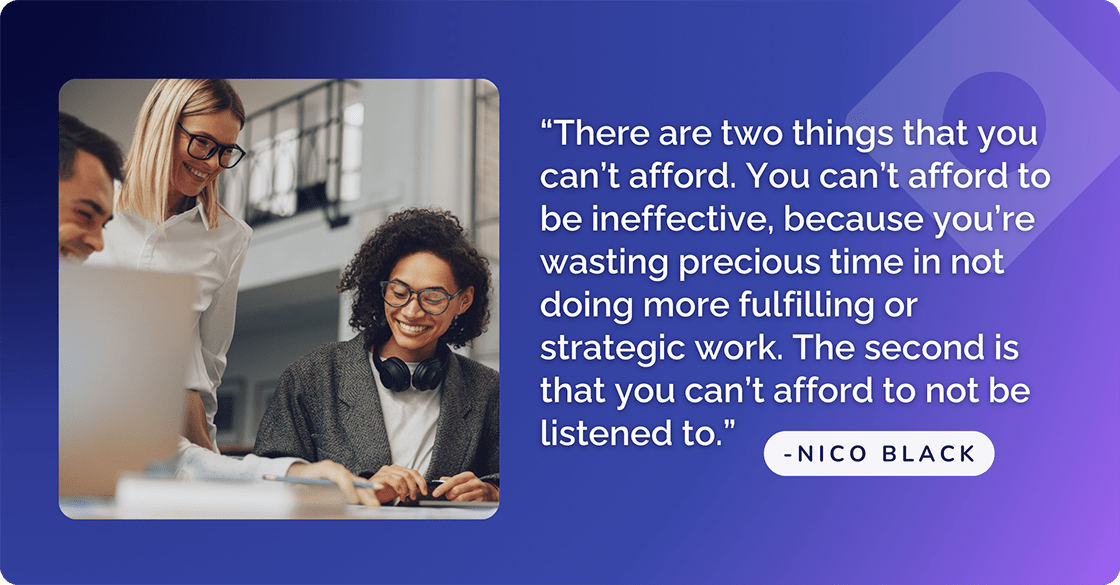It is crucial to align internal communications strategy and budget to drive organizational goals. Insight from our webinar will help you do this with confidence.


Internal communication is complicated. Learn how Cerkl Broadcast helps communicators focus on the important stuff and achieve their communication goals.
Access NowDan Ekstein, Founder of Tentpole Strategies, and Nico Black, Head of Growth at Cerkl, recently met online to talk about budgeting for internal communications (IC) software. The webinar, Stack & Plan: IC Strategies Before Budget Season, focused on setting the stage for impactful internal communications that drive organizational goals. Their message was that once you know where you’re going with your IC strategy, you will have actionable insights that will help you navigate the budget season with confidence.

“Today, communication leaders, specifically those focused on internal communications, are more experienced, have higher expectations on the tools and services they need to produce results because they know that real results are expected.” Dan Ekstein
Both Nico Black and Dan Ekstein have considerable experience and a particular interest in IC.
Dan maintains that internal comms are in his DNA. He founded Tentpole Strategies in 2020, but he and his colleagues have been in the internal communications business for more than two decades. Their primary interest is to help corporations and associations design and execute high-impact employee engagement programs that translate into business results.
Dan’s experience is impressive. He exited corporate America in 2012 after working for three Fortune 200 companies in their government-relations teams. During this time, he managed political action and civic engagement programs. Now, in addition to Tentpole, he is a partner in a public affairs firm that does IC employee engagement work that involves highly sensitive and regulated material.
Like Dan, Nico has been working closely with internal communicators. The difference is that Cerkl, which strives to modernize the digital experience for employees and communicators, has created a technology platform that is founded on insights from internal communicators.
As of 2024, Cerkl powers nearly 6 million employees in North America across industries that include technology, healthcare, and many others. Size-wise, they range from as few as 500 people to those that employ as many as 250,000. Nico explains the Cerkl approach: “Fundamentally when we interact with internal communicators, we like to say that they told us what they needed, and 85% of the time, we simply built it for them.” This means that important features come from internal communicators who indicate that they need them. The Cerkl Product Team listens and responds positively.
Dan highlights that after focusing on channels, and how we communicate, for the past two years, things are changing. Organizations seem to be taking a broader view of the ways internal communicators support businesses using the why and the what.
Similarly, while employee value propositions (EVPs) used to focus on attracting talent, now there is more awareness on career wellbeing. Internal communicators realize that this is the best way to retain talent and decrease turnover.
However, poor technology is still identified as one of the top challenges in the industry. A large percentage of internal communicators believe that their organization doesn’t invest enough in the technologies required to make IC succeed.
As Dan points out, the way we communicate and our use of technology are essential. The other factor is the need to explain the why, the what, and the context providing the purpose and value of communication.
“I think the opportunity for a successful internal communications professional in many respects is to resell the organization back to the employee. You need to talk through change and re-establish the purpose and value of the organization and the employee’s mission to that.” Dan Ekstein

Of course, technology plays an important role in this. As more organizations focus on their EVP, it’s essential to have a strong IC platform. Ultimately, you need it to distribute content and then measure its effectiveness in real-time.
October is typically the month when budgets are set — commonly for the next calendar year. For internal communicators, this means thinking carefully about the tools and services already in use as well as new additions.
While both Dan and Nico are in the IC industry, Dan has been working from a consulting perspective with internal communicators. His focus is to understand people and processes. On the other hand, Nico works from a Cerkl Broadcast perspective, focusing on creating a technology platform that is predicated on insights from internal communicators. So, together, they set out to highlight insights from consulting (services) and software options (tools). However, the two are intertwined, and both must be considered when setting budgets.
“I believe that the internal comms professional has a unique role and responsibility,” says Dan. This means that time is an essential consideration.
"There are two things that you can’t afford. You can’t afford to be ineffective, because you’re wasting precious time in not doing more fulfilling or strategic work. The second is that you can’t afford to not be listened to.” Nico Black

This means that internal communicators need to assess what they need in their roles — and what they need to make it happen. “Being dependent on third parties, even if they’re stakeholders, for the success of your specific position is incredibly frustrating and very difficult.”
This is where Cerkl Broadcast comes in, by providing software and the technologies to make it happen by producing a consumer-grade experience. Nico likens this to the experience consumers on Amazon or Netflix are offered.
But making choices and changes can be a challenge.
You can’t escape costs, says Dan. There are hard costs (license and set-up fees) and soft costs (inter-company cost centers). There is also the factor of timing to onboard as well as ongoing support needs. For example:
Any transition needs to be as smooth as possible.
If there’s market consolidation, particularly with mergers and acquisitions (M&As), issues with hiring and laying off are common. This is one of those times when effective internal communications are critical, says Nico. Management isn’t going to want to wait 10, 12, or 18 months to integrate systems, people, and cultures. Issues like survivor guilt and disengagement are very real at a time like this.
So, what’s the best way to overcome these issues? With new people on the scene, it might be the perfect opportunity to buy into a new comms platform.
Dan points out that many internal communicators may not be the decision-makers when it comes to choosing which platform to use. “So, understanding how tools will integrate with other tools like Workday or Sap, is really important — whatever the tool may be, your enterprise, communication systems, your intranets.”
It is also vital to consider information security and risk protocols. Another hugely important consideration for a high-impact IC program is reporting and analytics.
The question, says Nico, is, Do you have the tools? Not just to cover what’s expected of you, but tools that will respond to the fast-paced macro trends we haven’t seen yet? Lots of organizations assume that it’s business as usual. But it isn’t. “The same doesn’t work anymore!”
It’s important to know what meets your current needs, but it’s also important to think about the future when choosing new tools or a new platform.
Another vital element is to consider whether you need to hire more people to get things done or whether to create better processes. These can be more efficient if you choose the right technologies and tools.
Ultimately, if you have the right team and tools in place, you will have a win-win scenario. This can make communicators more efficient. It can also help to reduce stress and the time spent on tasks. This creates more value for the organization.
“You shouldn’t settle for the platform you have if it’s really not working for you effectively. It’s important to understand the tools that you have. But it’s also important to embrace the role you have in internal communications, what your responsibilities are, and how the platform can help amplify that message.” Dan Ekstein
Getting back to basics, the initial software capabilities Dan advises people to consider are:
In a word, data is invaluable. As Dan says, “Data is the lifeblood of the best-in-class employee engagement program and platform.” He warns that if internal communicators ignore the value of their organization’s data and don’t use it to maximize employee engagement, they are making a big mistake.
Bearing this in mind, most companies Cerkl talks to are email-based, says Nico. There’s nothing wrong with that… except that when they’re using Gmail or Outlook, they don’t don’t have analytics. That means that internal communicators can’t retarget messaging. They don’t have a way to confirm whether or not employees have read their messages. They aren’t able to sequence communications in a way that really works. When they build newsletters, they generally do this manually, which is time-consuming.
Reporting and analytics are vital. You need to easily see the information going out and know that people are opening messages. You also need to know whether or not they are taking action on them so you can report back to the right people.
One of the questions raised during the webinar was whether AI is good or bad for those working in the field of IC.
Dan believes it is good. He also believes that technology in general is a good thing. While there is some fear around AI, if you are thoughtful, “AI technology should help make you bigger, faster, stronger, and better.”
As Nico pointed out, AI is at the core of the Cerkl Broadcast platform. However, it’s different from generative AI. Cerkl uses AI for the pivotal mass personalization approach for dynamically building a News Digest. It also identifies whether people have read messages in one channel so they don’t get it repeated in another channel.
In a nutshell, Cerkl is using AI to work in a meaningful way for customers. It enables companies to work more strategically. Investing in Broadcast allows internal communicators to do more - and achieve more.
As Nico highlights, Broadcast offers users a consumer-grade experience. The platform is designed to let internal communicators do what empowers them by using best practices that allow them to do outstanding work.
He highlights three core components that define Cerkl:
While email is at the core of the platform, there are many other channels, and Cerkl undertakes to grow with customers.
Some other features include:
If you didn’t get to watch the webinar, now’s your chance. Make notes of any questions you have and then schedule a chat.